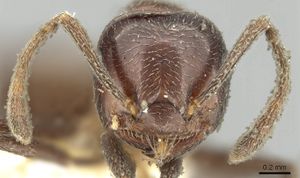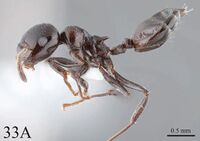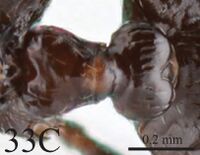Crematogaster pia
| Crematogaster pia | |
|---|---|

| |
| Scientific classification | |
| Kingdom: | Animalia |
| Phylum: | Arthropoda |
| Class: | Insecta |
| Order: | Hymenoptera |
| Family: | Formicidae |
| Subfamily: | Myrmicinae |
| Tribe: | Crematogastrini |
| Genus: | Crematogaster |
| Species group: | ranavalonae |
| Species: | C. pia |
| Binomial name | |
| Crematogaster pia Forel, 1911 | |
| Subspecies | |
| |
This species inhabits well-developed forests, where it makes carton nests and forages on trees.
Identification
A member of the Crematogaster ranavalonae-group.
Hosoishi (2015): This species is similar to Crematogaster butteli and Crematogaster tumidula, but differs from C. butteli in having an anterolaterally developed petiole, and from C. tumidula in having long propodeal spines.
Keys including this Species
Distribution
Latitudinal Distribution Pattern
Latitudinal Range: 3.9° to 3.9°.
| North Temperate |
North Subtropical |
Tropical | South Subtropical |
South Temperate |
- Source: AntMaps
Distribution based on Regional Taxon Lists
Indo-Australian Region: Malaysia (type locality).
Oriental Region: Thailand.
Distribution based on AntMaps
Distribution based on AntWeb specimens
Check data from AntWeb
Countries Occupied
| Number of countries occupied by this species based on AntWiki Regional Taxon Lists. In general, fewer countries occupied indicates a narrower range, while more countries indicates a more widespread species. |

|
Estimated Abundance
| Relative abundance based on number of AntMaps records per species (this species within the purple bar). Fewer records (to the left) indicates a less abundant/encountered species while more records (to the right) indicates more abundant/encountered species. |

|
Biology
Castes
Worker
Images from AntWeb
   
| |
| Syntype of Crematogaster tumidula pia. Worker. Specimen code casent0902126. Photographer Ryan Perry, uploaded by California Academy of Sciences. | Owned by NHMUK, London, UK. |
Nomenclature
The following information is derived from Barry Bolton's Online Catalogue of the Ants of the World.
- pia. Crematogaster tumidula subsp. pia Forel, 1911d: 384 (w.) WEST MALAYSIA.
- Type-material: lectotype worker (by designation of Hosoishi, 2015: 84), 10 paralectotype workers.
- Type-locality: lectotype Malaysia: Malacca, Negeri Sembilan, Berhentian Tingi (R. Martin); paralectotypes with same data.
- Type-depositories: MHNG (lectotype); MHNG, NHMB (paralectotypes).
- Combination in C. (Acrocoelia): Emery, 1922e: 151;
- combination in C. (Crematogaster): Bolton, 1995b: 166.
- Status as species: Emery, 1922e: 151; Chapman & Capco, 1951: 92; Bolton, 1995b: 160; Hosoishi, 2015: 84 (redescription); Khachonpisitsak, et al. 2020: 92.
- Distribution: Malaysia (Peninsula), Thailand.
- Current subspecies: nominal plus soengeiensis, taivanae.
Unless otherwise noted the text for the remainder of this section is reported from the publication that includes the original description.
Description
Worker
Hosoishi (2015) - (workers, n = 11). HW 0.90-0.96; HL 0.88-0.92; CI 102-108; SL 0.79-0.87; SI 83-94; EL 0.18-0.21; PW 0.54-0.59; WL 1.05-1.13; PSL 0.14-0.17; PtL 0.25-0.27; PtW 0.25-0.30; PtH 0.16-0.18; PpL 0.15-0.19; PpW 0.28- 0.31; PtHI 59-69; PtWI 96-115; PpWI 158-187; WI 103-115.
Head appearing subquadratic in front view. Mandible weakly striate, with four teeth, apical and subapincal teeth large, basal two teeth smaller. Scape exceeding posterior corner of head, with appressed setae, each of which is as long as width of scape in length. Compound eye large and slightly projecting beyond lateral margin of head in full face view.
Ventrolateral katepisternal ridge indistinct posteriorly. Propodeal spine long and stout; length longer than spiracle, dorsum as high as anterior propodeum in lateral view; basal width larger than spiracle in diameter. Propodeal spiracle large, situated close to propodeal declivity in lateral view, directed laterally.
In dorsal view, shape of petiole scoop with convex side, as broad as long. Anterolateral corner of petiole angulate. Petiolar spiracle big, as wide as half of propodeal spiracle in diameter, directed laterally. In dorsal view, postpetiole broader than long, bilobed but without longitudinal median sulcus. Postpetiole slightly wider than petiole in dorsal view.
Integument essentially smooth and shiny. Clypeus smooth and shiny without rugulae. Malar region smooth and shiny. Dorsal surface of promesonotum smooth and shiny. Lateral surface of pronotum smooth and shiny. Mesopleuron and lateral propodeum generally shiny, but with feable rugulae. Dorsal surface of propodeum smooth and shiny; anterior dorsum with feable rugulae.
Erect pilosity almost absent. Dorsum of head, clypeus and mesosoma with short and appressed sparse setae. Clypeus with one pair of longer setae on anteriormost portion, directed medially. Anterior clypeal margin with two or three pairs of longer setae on median portion, mixed with some shorter setae on side. No erect setae on pronotal shoulder. Posterolateral tubercle with some decumbent to appressed shorter setae. Ventral surface of petiole with appressed setae. Postpetiole with some shorter setae posteriorly. Fourth abdominal tergite with appressed setae.
Body color reddish brown to brownish.
Type Material
- Lectotype (designated by Hosoishi, 2015: 84), worker, Berhentian Tingi, Nigri Sembilan, Malacca, Malaysia, R. Martin, Musee d'Histoire Naturelle Genève.
- Paralectotype (designated by Hosoishi, 2015: 84), 5 workers, Berhentian Tingi, Nigri Sembilan, Malacca, Malaysia, R. Martin, Musee d'Histoire Naturelle Genève.
- Paralectotype (designated by Hosoishi, 2015: 84), 5 workers, Berhentian Tingi, Nigri Sembilan, Malacca, Malaysia, R. Martin, Naturhistorisches Museum, Basel.
References
- Emery, C. 1922c. Hymenoptera. Fam. Formicidae. Subfam. Myrmicinae. [part]. Genera Insectorum 174B: 95-206 (page 151, Combination in C. (Acrocoelia), and raised to species)
- Forel, A. 1911f. Fourmis nouvelles ou intéressantes. Bull. Soc. Vaudoise Sci. Nat. 47: 331-400 (page 384, worker described)
- Hosoishi, S. 2015. Revision of the Crematogaster ranavalonae-group in Asia, with description of two new species (Hymenoptera, Formicidae). Journal of Hymenoptera Research 42, 63-92.
- Khachonpisitsak, S., Yamane, S., Sriwichai, P., Jaitrong, W. 2020. An updated checklist of the ants of Thailand (Hymenoptera, Formicidae). ZooKeys 998, 1–182 (doi:10.3897/zookeys.998.54902).
References based on Global Ant Biodiversity Informatics
- Hosoishi S. 2015. Revision of the Crematogaster ranavalonae-group in Asia, with description of two new species (Hymenoptera, Formicidae). Journal of Hymenoptera Research 42: 63-92.

